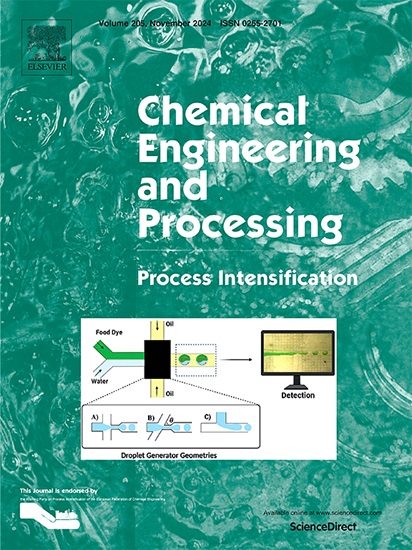大型质子离子液体合成反应器的设计与运行
IF 3.8
3区 工程技术
Q3 ENERGY & FUELS
Chemical Engineering and Processing - Process Intensification
Pub Date : 2025-04-08
DOI:10.1016/j.cep.2025.110312
引用次数: 0
摘要
在过去的三十年里,研究人员已经建立了离子液体作为工业应用中传统溶剂的绿色替代品的可能性,例如生物质的脱木质素。特别是质子离子液体(pil),由于其成本效益和简单的合成而受到了极大的关注。工业化的下一步是解决与这些新型溶剂大规模生产相关的挑战。PILs是通过酸和碱的中和合成的,其本质上涉及对金属具有腐蚀性和活性的高度放热反应。因此,在最大限度地提高反应堆吞吐量的同时,应围绕谨慎选择材料进行全面的设计研究。目前的研究重点是设计和操作一种具有灵活性的半批式反应器,使其可以很容易地切换到连续流反应器。该反应器已成功投产,生产80 w/w %硫酸氢三乙胺([TEA][HSO4] 80%) 0.8 kg h-1。放大分析表明,在单位体积功率恒定的基础上,将反应器的尺寸放大15倍,设计生产能力为105 kg h-1 [TEA][HSO4] 80%。到目前为止,我们已经生产了80 w/w %的N,N-二烷基丁基硫酸铵([DMBA][HSO4] 80%)和[TEA][HSO4]合计约800 kg。本文章由计算机程序翻译,如有差异,请以英文原文为准。

Design and operation of a cost-effective reactor for large protic ionic liquid synthesis
Over the past three decades, researchers have been establishing the possibility of ionic liquids as green alternatives to conventional solvents for industrial applications, such as the delignification of biomass. Protic ionic liquids (PILs), in particular, have gained significant attention due to their cost-effectiveness and straightforward synthesis. The next step towards industrialization is to address the challenges associated with the large-scale production of these novel solvents. PILs are synthesized through the neutralization of an acid and a base, which inherently involves highly exothermic reactions that are corrosive and reactive towards metals. Therefore, a comprehensive design study should be conducted around the careful selection of materials while maximizing reactor throughput. The current study focuses on the design and operation of a semi-batch reactor that exhibits flexibility, allowing it to be easily switched to a continuous-flow reactor. The reactor has been successfully commissioned to produce 0.8 kg h-1 of 80 w/w % triethylamine hydrogen sulfate ([TEA][HSO4]80 %). The scale-up analysis showed that a reactor, which was scaled up by a factor of 15 in dimensions based on a constant power per unit volume, resulted in a design production capacity of 105 kg h-1 [TEA][HSO4]80 %. To date, we have produced ca. 800 kg 80 w/w % of N,N-dimtheylbutyl ammonium hydrogen sulfate ([DMBA][HSO4]80 %), and [TEA][HSO4]80 % combined.
求助全文
通过发布文献求助,成功后即可免费获取论文全文。
去求助
来源期刊
CiteScore
7.80
自引率
9.30%
发文量
408
审稿时长
49 days
期刊介绍:
Chemical Engineering and Processing: Process Intensification is intended for practicing researchers in industry and academia, working in the field of Process Engineering and related to the subject of Process Intensification.Articles published in the Journal demonstrate how novel discoveries, developments and theories in the field of Process Engineering and in particular Process Intensification may be used for analysis and design of innovative equipment and processing methods with substantially improved sustainability, efficiency and environmental performance.

 求助内容:
求助内容: 应助结果提醒方式:
应助结果提醒方式:


